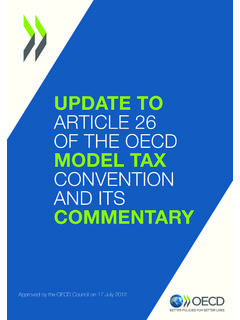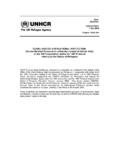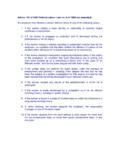Transcription of The Prayer Flag Tradition Website
1 The Prayer flag Tradition To me there are few things more beautiful than colorful Prayer flags fluttering in the wind- sometimes waving gently, sometimes raging; a dance of shadow and light. There is perhaps no simpler way to create good merit in this troubled world of ours than to put Prayer flags up for the benefit of other living beings. Prayer flags are not just pretty pieces of colored cloth with funny writing on them. The ancient Buddhist prayers, mantras and powerful symbols displayed on them produce a spiritual vibration that is activated and carried by the wind across the countryside. All beings that are touched by the wind are uplifted and a little happier. The silent prayers are blessings spoken on the breath of nature. Just as a drop of water can permeate the ocean, prayers dissolved in the wind extend to fill all of space.
2 The Prayer flag Tradition has a long continuous history dating back to ancient Tibet, China, Persia and India. The Tradition has now reached the West and is rapidly gaining popularity. The meanings behind Prayer flag texts and symbols, indeed behind the whole idea of Prayer flags, are based on the most profound concepts of Tibetan Buddhist philosophy. The Tibetan word for Prayer flag is Dar Cho. Dar means to increase life, fortune, health and wealth. Cho means all sentient beings. Prayer flags are simple devices that, coupled with the natural energy of the wind, quietly harmonize the environment, impartially increasing happiness and good fortune among all living beings. History According to some lamas Prayer flags date back thousands of years to the Bon Tradition of preBuddhist Tibet.
3 Shamanistic Bonpo priests used primary colored plain cloth flags in healing ceremonies. Each color corresponded to a different primary element - earth, water, fire, air and space the fundamental building blocks of both our physical bodies and of our environment. According to Eastern medicine health and harmony are produced through the balance of the 5 elements. Properly arranging colored flags around a sick patient harmonized the elements in his body helping to produce a state of physical and mental health. Colored flags were also used to help appease the local gods and spirits of the mountains, valleys, lakes and streams. These elemental beings, when provoked were thought to cause natural disasters and disease. Balancing the outer elements and propitiating the elemental spirits with rituals and offerings was the Bonpo way of pacifying nature and invoking the blessings of the gods.
4 It is not known whether or not the Bonpos ever wrote words on their flags. The preBuddhist religions of Tibet were oral traditions; writing was apparently limited to government bookkeeping. On the other hand the very word, bonpo, means one who recites magical formulas Even if no writing was added to the plain strips of cloth it is likely that the Bonpos painted sacred symbols on them. Some symbols seen on Buddhist Prayer flags today undoubtedly have Bonpo origins, their meaning now enhanced with the deep significance of Vajrayana Buddhist philosophy. From the first millennium AD Buddhism gradually assimilated into the Tibetan way of life reaching great zeal in the ninth century when the religious King of Tibet invited the powerful Indian meditation master, Guru Padmasambhava, to come and control the forces then impeding the spread of Buddhism.
5 Guru Rinpoche, as he is popularly known, bound the local Tibetan spirits by oath and transformed them into forces compatible with the spread of Buddhism. Some to the prayers seen on flags today were composed by Guru Rinpoche to pacify the spirits that cause disease and natural disasters. Originally the writing and images on Prayer flags were painted by hand, one at a time. Woodblocks, carefully carved in mirror image relief, were introduced from China in the 15th century. This invention made it possible to reproduce identical prints of the same design. Traditional designs could then be easily passed down from generation to generation. Famous Buddhist masters created most Prayer flag designs. Lay craftsmen make copies of the designs but would never think of actually creating a new design.
6 There are relatively few basic designs for a continuous Tradition that goes back over a thousand years. Aside from new designs no real innovations to the printing process have occurred in the past 500 years. Most Prayer flags imported to the West today are woodblock printed. Some shops are now starting to produce prints made from zinc faced blocks that can be etched photographically resulting in finer detail than the hand carved woodblock. Natural stone ground pigments have been replaced by printing inks, usually having a kerosene base. Most of the companies in the west prefer to use silkscreen printing techniques as wood carving is a time consuming skill requiring lengthy apprenticeship. When the Chinese took over Tibet they destroyed much of everything having to do with Tibetan culture and religion.
7 Prayer flags were discouraged but not entirely eliminated. We will never know how many traditional designs have been lost forever since the turmoil of China s cultural revolution. Because cloth and paper prints deteriorate so quickly the best way to preserve the ancient designs is by saving the woodblocks. Woodblocks, often weighing several pounds, were too heavy for the refugees to lug over the Himalayas and woodblocks no doubt made wonderful firewood for Chinese troops. Most of the traditional Prayer flags today are made in Nepal and India by Tibetan refugees or by Nepali Buddhists from the Tibetan border regions. Texts Early in the 7th Century the Tibetan King Song Tsen Gompo sent his minister to India to learn Sanskrit and writing. The Tibetan script we see today on Prayer flags was modeled after an Indian script used at that time.
8 Texts seen on Prayer flags can be broadly categorized as mantra, sutra and prayers. A mantra is a power-laden syllable or series of syllables or sounds with the capacity of influencing certain energy dimensions. The vibration of mantra can control the invisible energies and occult forces that govern existence. Continuous repetition of mantras is practiced as a form of meditation in many Buddhist schools. Mantras are almost always in Sanskrit the ancient language of Hinduism and Buddhism. They range in length from a single seed syllable like OM to long mantras such as the Hundred-syllable mantra of Vajrasattva. They are not really translatable; their inner meanings are beyond words. Probably the oldest Buddhist mantra and still the most widespread among Tibetans is the six-syllable mantra of Avalokiteshvara, the bodhisattva of compassion.
9 OM MANI PADME HUNG! Printed on Prayer flags the mantra sends blessings of compassion to the six worldly realms. Sutras are prose texts based on the discourses directly derived from Shakyamuni Buddha, the historical Buddha who taught in India 2500 years ago. Many sutras have long, medium and short versions. Prayer flags use the medium or short versions. One short form of sutra often seen on Prayer flag is the dharani. Closely related to mantras, dharanis contain magical formulas comprised of syllables with symbolic content. They can convey the essence of a teaching or a particular state of mind. The Victory Banner (Gyaltsen Semo) contains many lines of dharani. Praise to the 21 Taras, the Long Life flag and the White Umbrella are also examples of Prayer flags using Sutras.
10 For purposes of categorization all the other text seen on Prayer flags can fall under the general term prayers. These would include supplications, aspirations and good wishes written by various masters throughout the history of Mahayana Buddhism Symbols In an article this size it is impossible to adequately explain the meanings of all the symbols used on Tibetan Prayer flags. Symbols by definition have meanings larger than their mere appearance. In the case of sacred Buddhist symbols the meanings are often hinting at vast notions beyond words. Long treatises have been written on the meanings of such symbols. Listed below are brief meaning of some of the more common symbols. The Wind Horse (Lung-ta) carrying the Wish Fulfilling Jewel of Enlightenment is the most prevalent symbol used on Prayer flags.





